PMN610: Gateway Bridge Construction Project Report, Brisbane QLD
VerifiedAdded on 2022/10/06
|24
|5752
|127
Report
AI Summary
This report provides a comprehensive feasibility study of the Gateway Bridge and its duplication project in Brisbane, Australia. It begins with an executive summary and a table of contents, outlining the project's needs, which are articulated by analyzing the business case. The report then delves into options analysis using multiple criteria assessment, project definition, constraints, dependencies, deliverables, and performance measures. The project approach, including management strategies, budget analysis, program, and risk assessment are also detailed. The report includes a time frame, cost and budget analysis, risk strategy, quality management, and a project completion strategy. Furthermore, it incorporates a benefits realization plan and concludes with references and appendices containing a cost plan, risk register, benefits realization plan, financial analysis, environmental assessment, and a stakeholder assessment matrix. The project aims to address traffic congestion and improve infrastructure, offering a detailed overview of the project's lifecycle from initiation to completion.
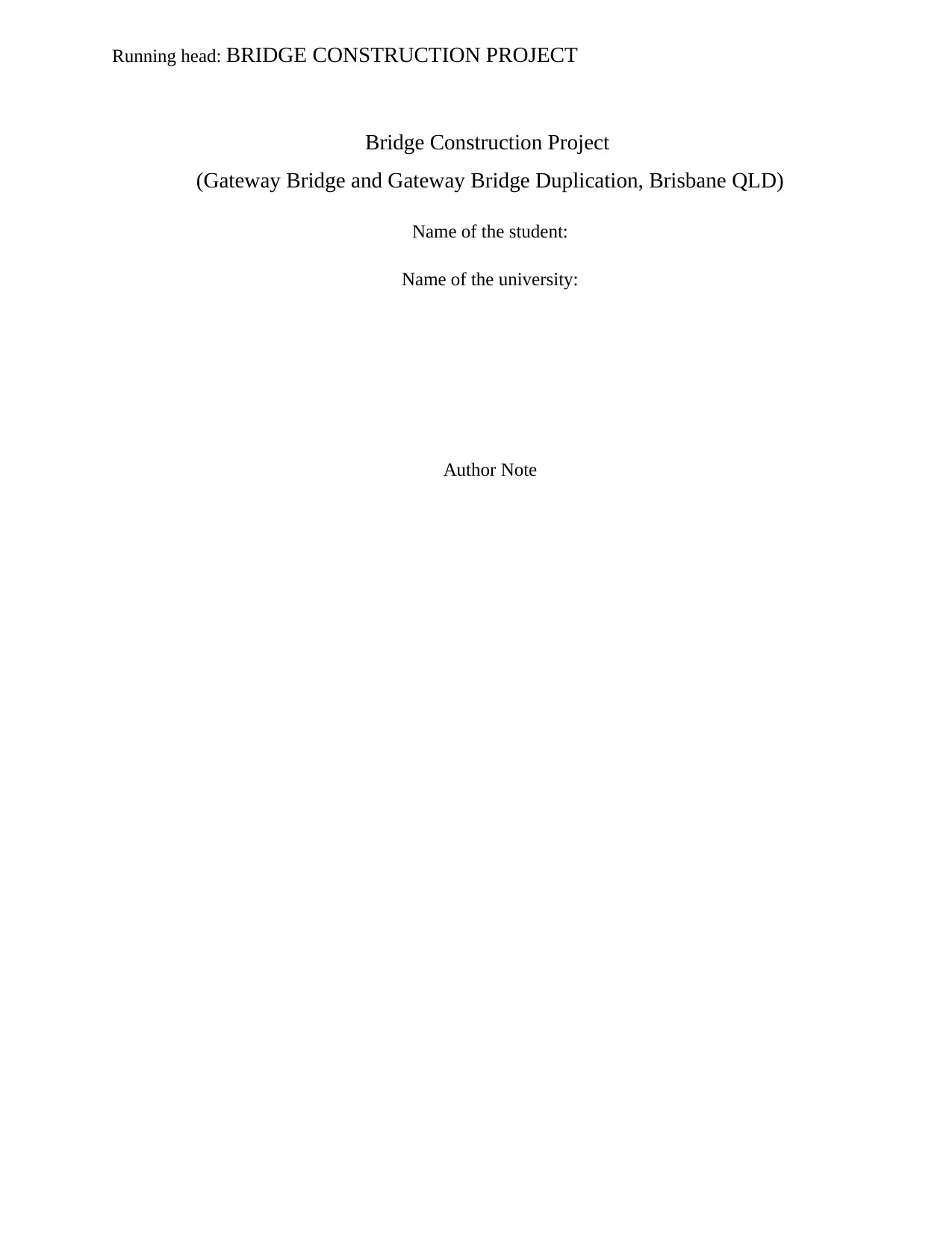
Running head: BRIDGE CONSTRUCTION PROJECT
Bridge Construction Project
(Gateway Bridge and Gateway Bridge Duplication, Brisbane QLD)
Name of the student:
Name of the university:
Author Note
Bridge Construction Project
(Gateway Bridge and Gateway Bridge Duplication, Brisbane QLD)
Name of the student:
Name of the university:
Author Note
Paraphrase This Document
Need a fresh take? Get an instant paraphrase of this document with our AI Paraphraser
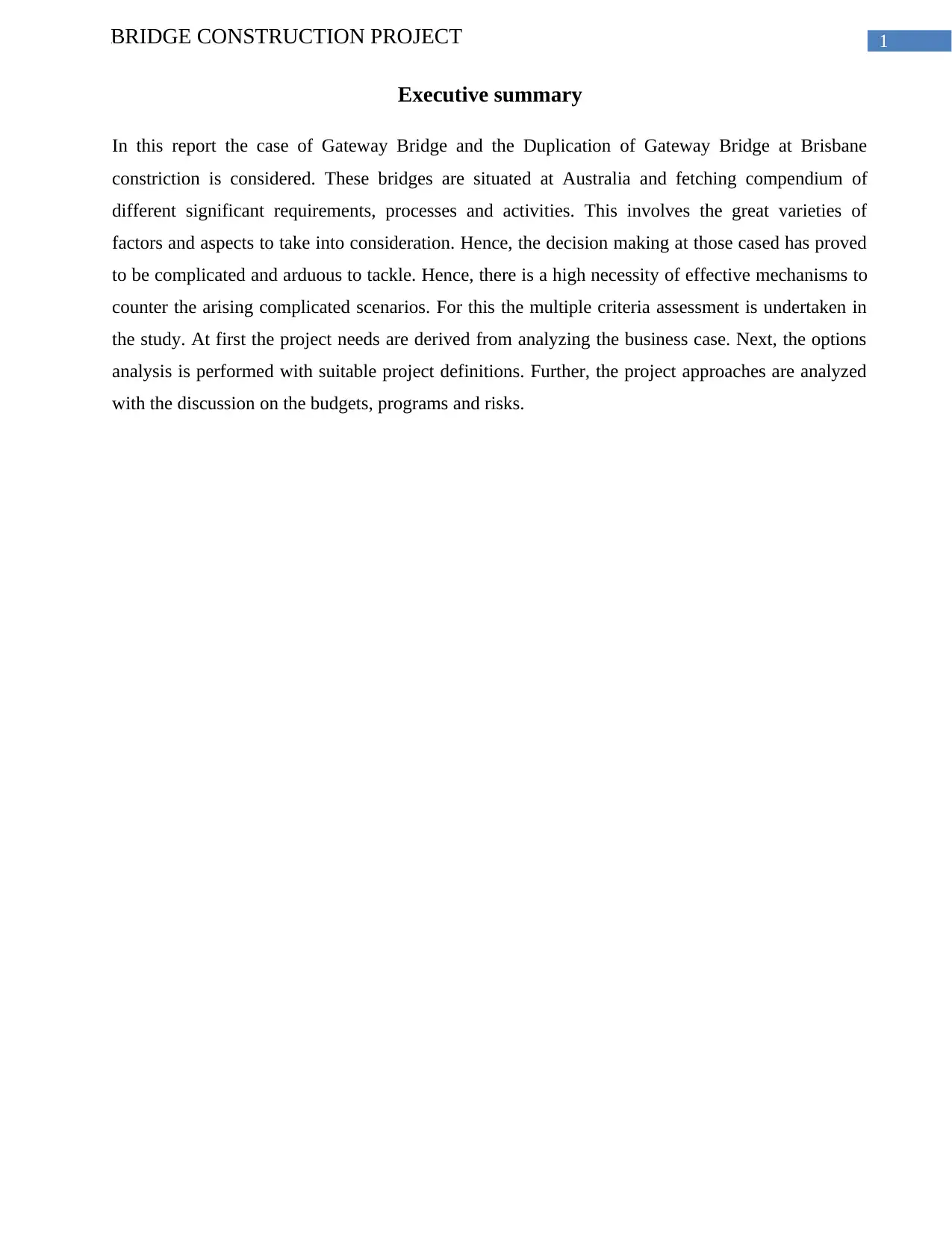
1BRIDGE CONSTRUCTION PROJECT
Executive summary
In this report the case of Gateway Bridge and the Duplication of Gateway Bridge at Brisbane
constriction is considered. These bridges are situated at Australia and fetching compendium of
different significant requirements, processes and activities. This involves the great varieties of
factors and aspects to take into consideration. Hence, the decision making at those cased has proved
to be complicated and arduous to tackle. Hence, there is a high necessity of effective mechanisms to
counter the arising complicated scenarios. For this the multiple criteria assessment is undertaken in
the study. At first the project needs are derived from analyzing the business case. Next, the options
analysis is performed with suitable project definitions. Further, the project approaches are analyzed
with the discussion on the budgets, programs and risks.
Executive summary
In this report the case of Gateway Bridge and the Duplication of Gateway Bridge at Brisbane
constriction is considered. These bridges are situated at Australia and fetching compendium of
different significant requirements, processes and activities. This involves the great varieties of
factors and aspects to take into consideration. Hence, the decision making at those cased has proved
to be complicated and arduous to tackle. Hence, there is a high necessity of effective mechanisms to
counter the arising complicated scenarios. For this the multiple criteria assessment is undertaken in
the study. At first the project needs are derived from analyzing the business case. Next, the options
analysis is performed with suitable project definitions. Further, the project approaches are analyzed
with the discussion on the budgets, programs and risks.
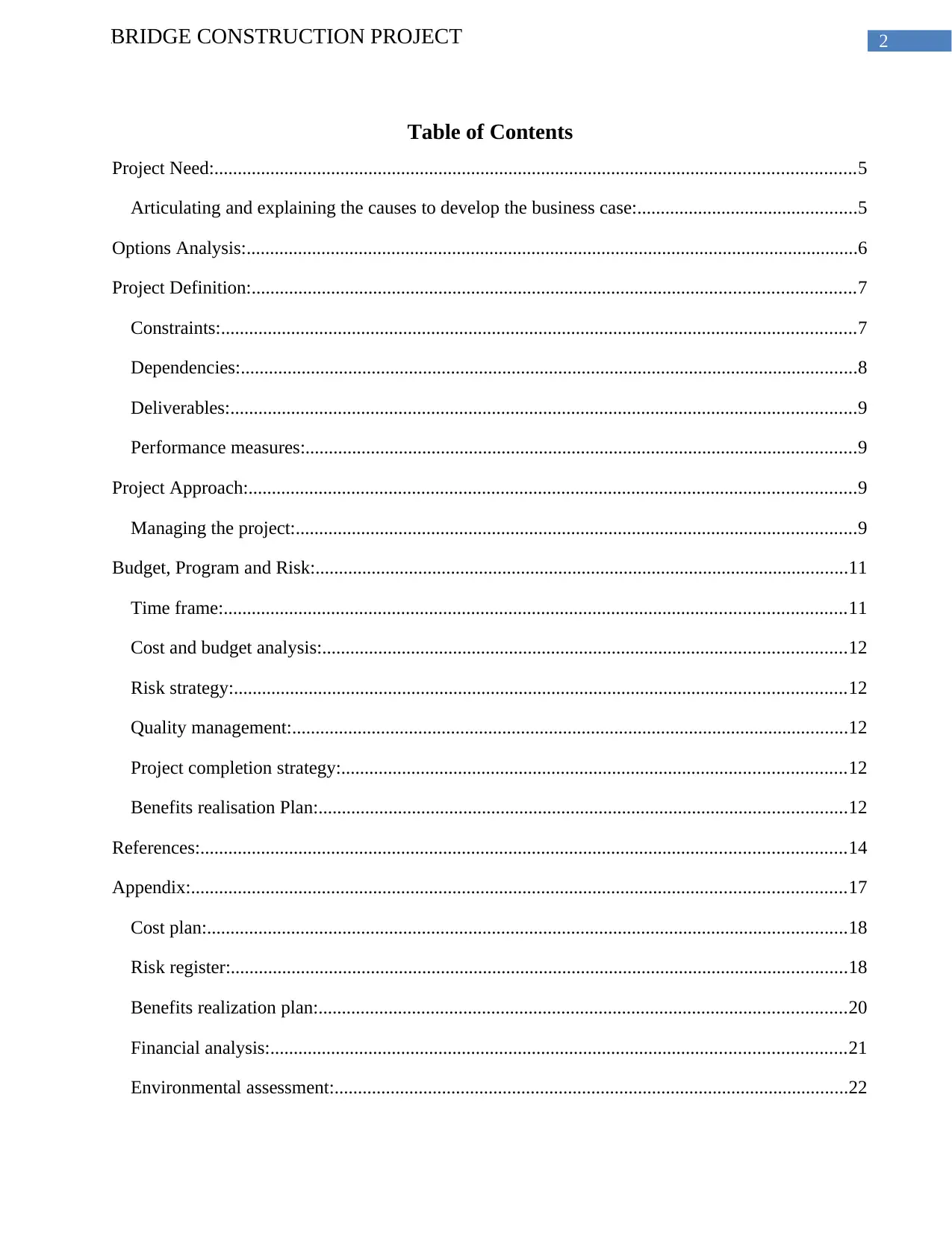
2BRIDGE CONSTRUCTION PROJECT
Table of Contents
Project Need:.........................................................................................................................................5
Articulating and explaining the causes to develop the business case:...............................................5
Options Analysis:...................................................................................................................................6
Project Definition:.................................................................................................................................7
Constraints:........................................................................................................................................7
Dependencies:....................................................................................................................................8
Deliverables:......................................................................................................................................9
Performance measures:......................................................................................................................9
Project Approach:..................................................................................................................................9
Managing the project:........................................................................................................................9
Budget, Program and Risk:..................................................................................................................11
Time frame:.....................................................................................................................................11
Cost and budget analysis:................................................................................................................12
Risk strategy:...................................................................................................................................12
Quality management:.......................................................................................................................12
Project completion strategy:............................................................................................................12
Benefits realisation Plan:.................................................................................................................12
References:..........................................................................................................................................14
Appendix:............................................................................................................................................17
Cost plan:.........................................................................................................................................18
Risk register:....................................................................................................................................18
Benefits realization plan:.................................................................................................................20
Financial analysis:...........................................................................................................................21
Environmental assessment:..............................................................................................................22
Table of Contents
Project Need:.........................................................................................................................................5
Articulating and explaining the causes to develop the business case:...............................................5
Options Analysis:...................................................................................................................................6
Project Definition:.................................................................................................................................7
Constraints:........................................................................................................................................7
Dependencies:....................................................................................................................................8
Deliverables:......................................................................................................................................9
Performance measures:......................................................................................................................9
Project Approach:..................................................................................................................................9
Managing the project:........................................................................................................................9
Budget, Program and Risk:..................................................................................................................11
Time frame:.....................................................................................................................................11
Cost and budget analysis:................................................................................................................12
Risk strategy:...................................................................................................................................12
Quality management:.......................................................................................................................12
Project completion strategy:............................................................................................................12
Benefits realisation Plan:.................................................................................................................12
References:..........................................................................................................................................14
Appendix:............................................................................................................................................17
Cost plan:.........................................................................................................................................18
Risk register:....................................................................................................................................18
Benefits realization plan:.................................................................................................................20
Financial analysis:...........................................................................................................................21
Environmental assessment:..............................................................................................................22
⊘ This is a preview!⊘
Do you want full access?
Subscribe today to unlock all pages.

Trusted by 1+ million students worldwide
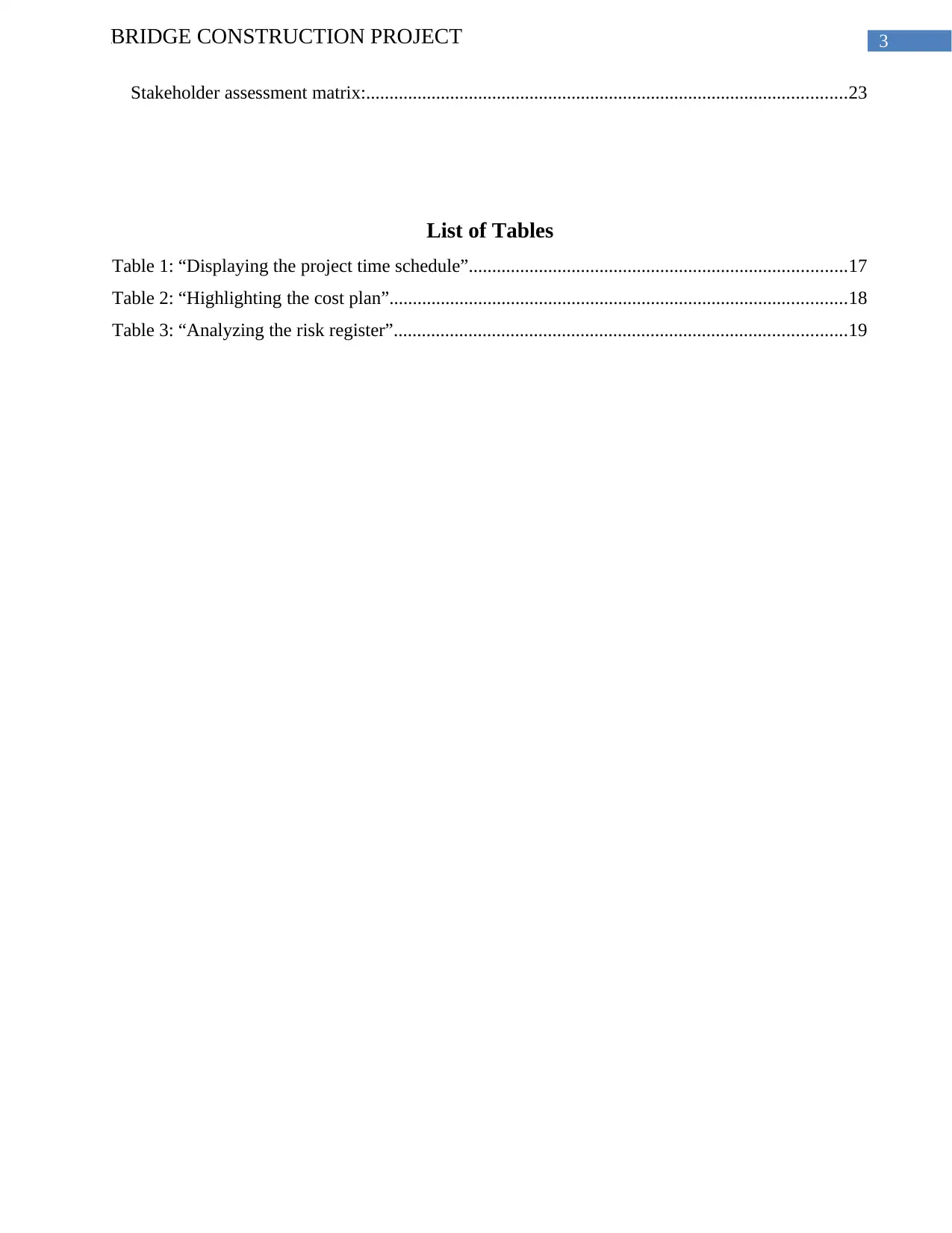
3BRIDGE CONSTRUCTION PROJECT
Stakeholder assessment matrix:.......................................................................................................23
List of Tables
Table 1: “Displaying the project time schedule”.................................................................................17
Table 2: “Highlighting the cost plan”..................................................................................................18
Table 3: “Analyzing the risk register”.................................................................................................19
Stakeholder assessment matrix:.......................................................................................................23
List of Tables
Table 1: “Displaying the project time schedule”.................................................................................17
Table 2: “Highlighting the cost plan”..................................................................................................18
Table 3: “Analyzing the risk register”.................................................................................................19
Paraphrase This Document
Need a fresh take? Get an instant paraphrase of this document with our AI Paraphraser
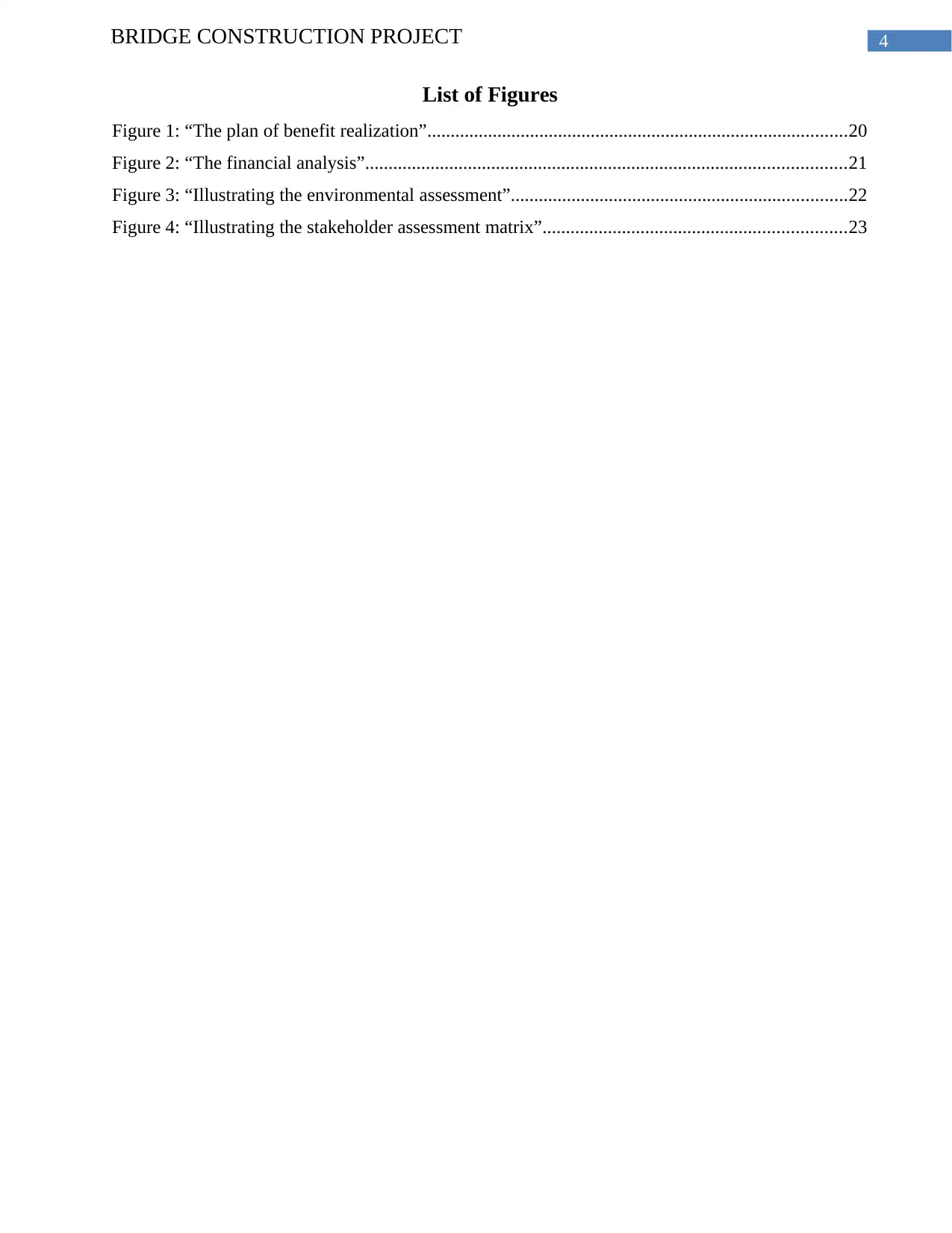
4BRIDGE CONSTRUCTION PROJECT
List of Figures
Figure 1: “The plan of benefit realization”..........................................................................................20
Figure 2: “The financial analysis”.......................................................................................................21
Figure 3: “Illustrating the environmental assessment”........................................................................22
Figure 4: “Illustrating the stakeholder assessment matrix”.................................................................23
List of Figures
Figure 1: “The plan of benefit realization”..........................................................................................20
Figure 2: “The financial analysis”.......................................................................................................21
Figure 3: “Illustrating the environmental assessment”........................................................................22
Figure 4: “Illustrating the stakeholder assessment matrix”.................................................................23
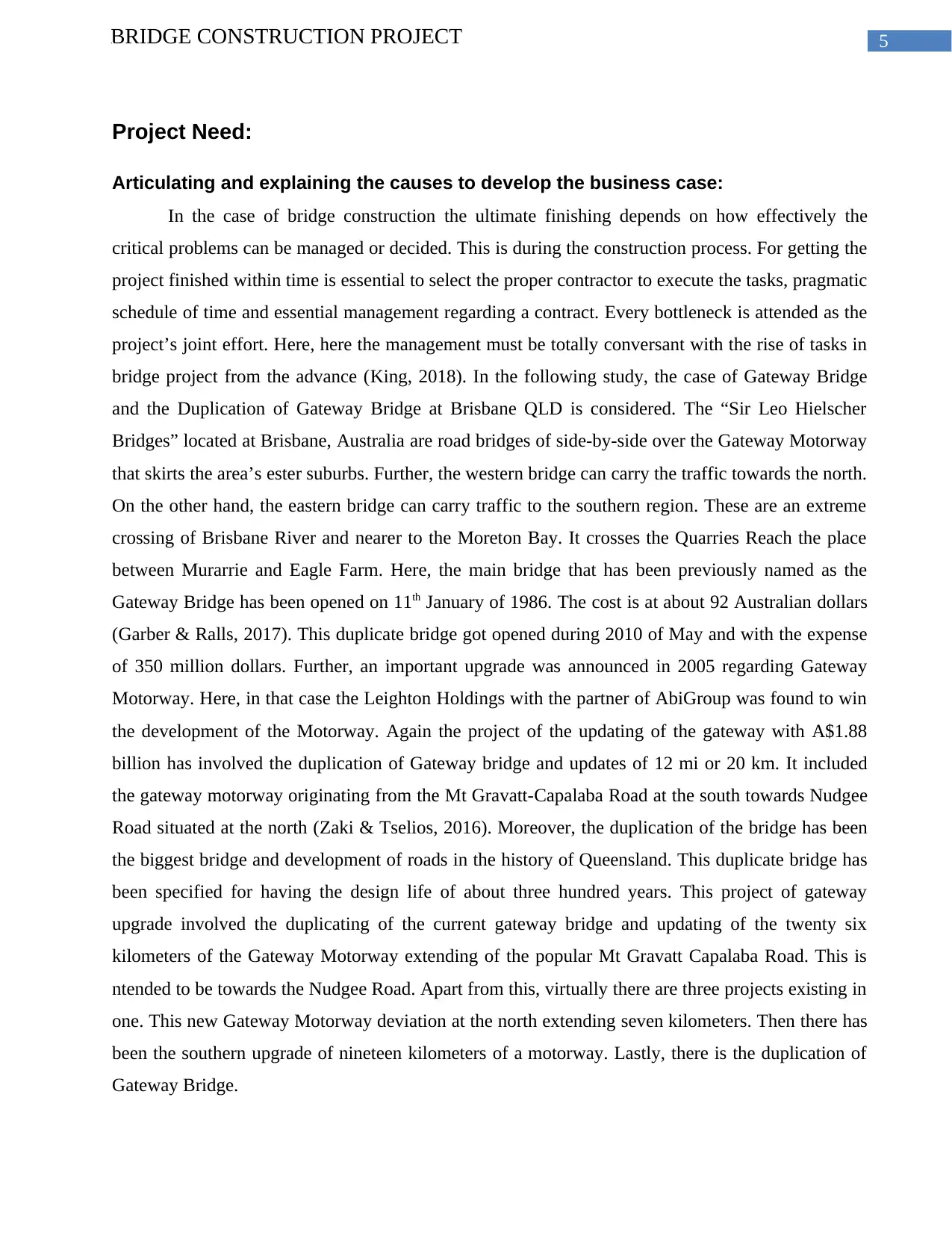
5BRIDGE CONSTRUCTION PROJECT
Project Need:
Articulating and explaining the causes to develop the business case:
In the case of bridge construction the ultimate finishing depends on how effectively the
critical problems can be managed or decided. This is during the construction process. For getting the
project finished within time is essential to select the proper contractor to execute the tasks, pragmatic
schedule of time and essential management regarding a contract. Every bottleneck is attended as the
project’s joint effort. Here, here the management must be totally conversant with the rise of tasks in
bridge project from the advance (King, 2018). In the following study, the case of Gateway Bridge
and the Duplication of Gateway Bridge at Brisbane QLD is considered. The “Sir Leo Hielscher
Bridges” located at Brisbane, Australia are road bridges of side-by-side over the Gateway Motorway
that skirts the area’s ester suburbs. Further, the western bridge can carry the traffic towards the north.
On the other hand, the eastern bridge can carry traffic to the southern region. These are an extreme
crossing of Brisbane River and nearer to the Moreton Bay. It crosses the Quarries Reach the place
between Murarrie and Eagle Farm. Here, the main bridge that has been previously named as the
Gateway Bridge has been opened on 11th January of 1986. The cost is at about 92 Australian dollars
(Garber & Ralls, 2017). This duplicate bridge got opened during 2010 of May and with the expense
of 350 million dollars. Further, an important upgrade was announced in 2005 regarding Gateway
Motorway. Here, in that case the Leighton Holdings with the partner of AbiGroup was found to win
the development of the Motorway. Again the project of the updating of the gateway with A$1.88
billion has involved the duplication of Gateway bridge and updates of 12 mi or 20 km. It included
the gateway motorway originating from the Mt Gravatt-Capalaba Road at the south towards Nudgee
Road situated at the north (Zaki & Tselios, 2016). Moreover, the duplication of the bridge has been
the biggest bridge and development of roads in the history of Queensland. This duplicate bridge has
been specified for having the design life of about three hundred years. This project of gateway
upgrade involved the duplicating of the current gateway bridge and updating of the twenty six
kilometers of the Gateway Motorway extending of the popular Mt Gravatt Capalaba Road. This is
ntended to be towards the Nudgee Road. Apart from this, virtually there are three projects existing in
one. This new Gateway Motorway deviation at the north extending seven kilometers. Then there has
been the southern upgrade of nineteen kilometers of a motorway. Lastly, there is the duplication of
Gateway Bridge.
Project Need:
Articulating and explaining the causes to develop the business case:
In the case of bridge construction the ultimate finishing depends on how effectively the
critical problems can be managed or decided. This is during the construction process. For getting the
project finished within time is essential to select the proper contractor to execute the tasks, pragmatic
schedule of time and essential management regarding a contract. Every bottleneck is attended as the
project’s joint effort. Here, here the management must be totally conversant with the rise of tasks in
bridge project from the advance (King, 2018). In the following study, the case of Gateway Bridge
and the Duplication of Gateway Bridge at Brisbane QLD is considered. The “Sir Leo Hielscher
Bridges” located at Brisbane, Australia are road bridges of side-by-side over the Gateway Motorway
that skirts the area’s ester suburbs. Further, the western bridge can carry the traffic towards the north.
On the other hand, the eastern bridge can carry traffic to the southern region. These are an extreme
crossing of Brisbane River and nearer to the Moreton Bay. It crosses the Quarries Reach the place
between Murarrie and Eagle Farm. Here, the main bridge that has been previously named as the
Gateway Bridge has been opened on 11th January of 1986. The cost is at about 92 Australian dollars
(Garber & Ralls, 2017). This duplicate bridge got opened during 2010 of May and with the expense
of 350 million dollars. Further, an important upgrade was announced in 2005 regarding Gateway
Motorway. Here, in that case the Leighton Holdings with the partner of AbiGroup was found to win
the development of the Motorway. Again the project of the updating of the gateway with A$1.88
billion has involved the duplication of Gateway bridge and updates of 12 mi or 20 km. It included
the gateway motorway originating from the Mt Gravatt-Capalaba Road at the south towards Nudgee
Road situated at the north (Zaki & Tselios, 2016). Moreover, the duplication of the bridge has been
the biggest bridge and development of roads in the history of Queensland. This duplicate bridge has
been specified for having the design life of about three hundred years. This project of gateway
upgrade involved the duplicating of the current gateway bridge and updating of the twenty six
kilometers of the Gateway Motorway extending of the popular Mt Gravatt Capalaba Road. This is
ntended to be towards the Nudgee Road. Apart from this, virtually there are three projects existing in
one. This new Gateway Motorway deviation at the north extending seven kilometers. Then there has
been the southern upgrade of nineteen kilometers of a motorway. Lastly, there is the duplication of
Gateway Bridge.
⊘ This is a preview!⊘
Do you want full access?
Subscribe today to unlock all pages.

Trusted by 1+ million students worldwide
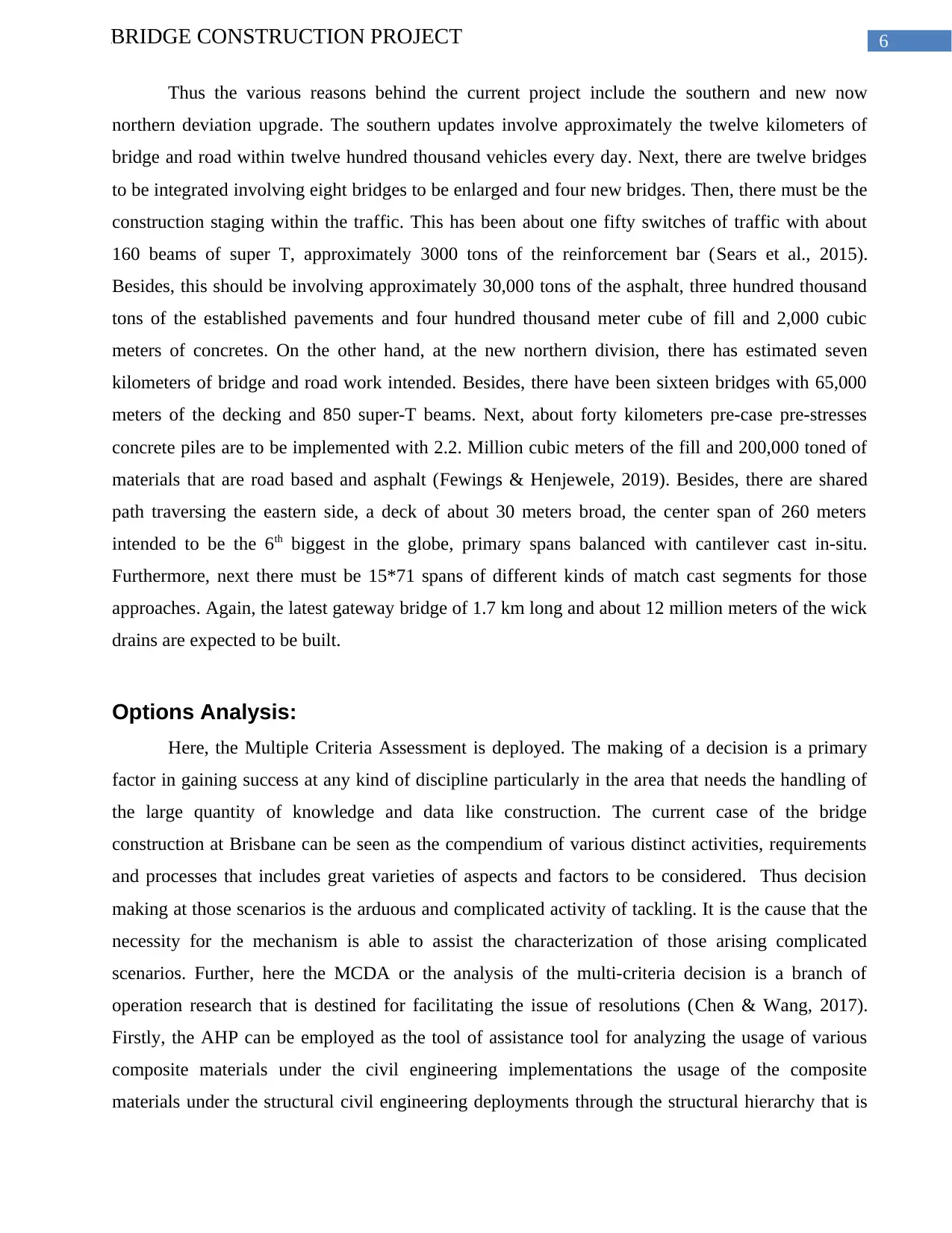
6BRIDGE CONSTRUCTION PROJECT
Thus the various reasons behind the current project include the southern and new now
northern deviation upgrade. The southern updates involve approximately the twelve kilometers of
bridge and road within twelve hundred thousand vehicles every day. Next, there are twelve bridges
to be integrated involving eight bridges to be enlarged and four new bridges. Then, there must be the
construction staging within the traffic. This has been about one fifty switches of traffic with about
160 beams of super T, approximately 3000 tons of the reinforcement bar (Sears et al., 2015).
Besides, this should be involving approximately 30,000 tons of the asphalt, three hundred thousand
tons of the established pavements and four hundred thousand meter cube of fill and 2,000 cubic
meters of concretes. On the other hand, at the new northern division, there has estimated seven
kilometers of bridge and road work intended. Besides, there have been sixteen bridges with 65,000
meters of the decking and 850 super-T beams. Next, about forty kilometers pre-case pre-stresses
concrete piles are to be implemented with 2.2. Million cubic meters of the fill and 200,000 toned of
materials that are road based and asphalt (Fewings & Henjewele, 2019). Besides, there are shared
path traversing the eastern side, a deck of about 30 meters broad, the center span of 260 meters
intended to be the 6th biggest in the globe, primary spans balanced with cantilever cast in-situ.
Furthermore, next there must be 15*71 spans of different kinds of match cast segments for those
approaches. Again, the latest gateway bridge of 1.7 km long and about 12 million meters of the wick
drains are expected to be built.
Options Analysis:
Here, the Multiple Criteria Assessment is deployed. The making of a decision is a primary
factor in gaining success at any kind of discipline particularly in the area that needs the handling of
the large quantity of knowledge and data like construction. The current case of the bridge
construction at Brisbane can be seen as the compendium of various distinct activities, requirements
and processes that includes great varieties of aspects and factors to be considered. Thus decision
making at those scenarios is the arduous and complicated activity of tackling. It is the cause that the
necessity for the mechanism is able to assist the characterization of those arising complicated
scenarios. Further, here the MCDA or the analysis of the multi-criteria decision is a branch of
operation research that is destined for facilitating the issue of resolutions (Chen & Wang, 2017).
Firstly, the AHP can be employed as the tool of assistance tool for analyzing the usage of various
composite materials under the civil engineering implementations the usage of the composite
materials under the structural civil engineering deployments through the structural hierarchy that is
Thus the various reasons behind the current project include the southern and new now
northern deviation upgrade. The southern updates involve approximately the twelve kilometers of
bridge and road within twelve hundred thousand vehicles every day. Next, there are twelve bridges
to be integrated involving eight bridges to be enlarged and four new bridges. Then, there must be the
construction staging within the traffic. This has been about one fifty switches of traffic with about
160 beams of super T, approximately 3000 tons of the reinforcement bar (Sears et al., 2015).
Besides, this should be involving approximately 30,000 tons of the asphalt, three hundred thousand
tons of the established pavements and four hundred thousand meter cube of fill and 2,000 cubic
meters of concretes. On the other hand, at the new northern division, there has estimated seven
kilometers of bridge and road work intended. Besides, there have been sixteen bridges with 65,000
meters of the decking and 850 super-T beams. Next, about forty kilometers pre-case pre-stresses
concrete piles are to be implemented with 2.2. Million cubic meters of the fill and 200,000 toned of
materials that are road based and asphalt (Fewings & Henjewele, 2019). Besides, there are shared
path traversing the eastern side, a deck of about 30 meters broad, the center span of 260 meters
intended to be the 6th biggest in the globe, primary spans balanced with cantilever cast in-situ.
Furthermore, next there must be 15*71 spans of different kinds of match cast segments for those
approaches. Again, the latest gateway bridge of 1.7 km long and about 12 million meters of the wick
drains are expected to be built.
Options Analysis:
Here, the Multiple Criteria Assessment is deployed. The making of a decision is a primary
factor in gaining success at any kind of discipline particularly in the area that needs the handling of
the large quantity of knowledge and data like construction. The current case of the bridge
construction at Brisbane can be seen as the compendium of various distinct activities, requirements
and processes that includes great varieties of aspects and factors to be considered. Thus decision
making at those scenarios is the arduous and complicated activity of tackling. It is the cause that the
necessity for the mechanism is able to assist the characterization of those arising complicated
scenarios. Further, here the MCDA or the analysis of the multi-criteria decision is a branch of
operation research that is destined for facilitating the issue of resolutions (Chen & Wang, 2017).
Firstly, the AHP can be employed as the tool of assistance tool for analyzing the usage of various
composite materials under the civil engineering implementations the usage of the composite
materials under the structural civil engineering deployments through the structural hierarchy that is
Paraphrase This Document
Need a fresh take? Get an instant paraphrase of this document with our AI Paraphraser

7BRIDGE CONSTRUCTION PROJECT
quasi-sustainable in nature. Besides a weighing-AHP of various needed factors in developing the
Assessment of “Life Cycle Benefit Cost” composite materials. This proposition has been clarified
with the practical instance where the rehabilitation of the current bridge can be studied through
traditional or composite solutions. Apart from this, a DEA approach can be deployed for analyzing
how the rock-blasting can work. Here, the inputs can be divided into labor, commodity, machine
capita and transport. On the other hand, the output can be defined as the effective amount of volume
of the blasted rock as the process goes on. It can be determined that both the outputs and inputs can
be managed more effectively. Further, the DEA model can be used or calculating the affectivity of
the trucks as the maintenance and construction stage goes on (Nakayama et al., 2016). Additionally,
the ELECRE III process to analyze the different waste management system can be deployed.
Various makers of decisions have been found to contributing the veto thresholds and criteria weights
that can be utilized for evaluating various alternative under the environmental and economic terms.
Again, the TOPIS-based Taguchi approach for optimizing the admixture proportions of the HSCC or
the high strength self-compacting concrete. This has been resulting under the multi-response issue
where the aim is to optimize the factors of six factors that have been characterizing that. At this case,
the outcomes can be compared with those that are been retrieved through utilizing the RSM or
Response Surface Method. Further, the interdependence has been among the risk problems of the
present bridge construction at Brisbane for developing the ANP systems for accurately appraising
the effect of those factors. Thus through creating the super-matrix of the various kinds of
interrelationships among the risk elements, the effects are calculated through interpreting priority
users of the obtained weights (Larsson et al., 2015). Apart from this, the issue of construction bid
investigation can be performed through the GTD or Grey Target model. This, as the target pursued is
defined many grey ides can be introduced or finding the effective closeness of various scenarios to
this value. Thus as the pursued target is defined, many grey ideas are introduced for determined the
closeness of various scenarios to those values. Despite leaving the issue of bidding, the calculation
of the grey calculation coefficient to select the closest bidder to that ideal. This indicators of the
evaluations are to be standardized as per the range of different index values that have been reflecting
preferences of the tenders.
Project Definition:
The various recommended options are as follows.
quasi-sustainable in nature. Besides a weighing-AHP of various needed factors in developing the
Assessment of “Life Cycle Benefit Cost” composite materials. This proposition has been clarified
with the practical instance where the rehabilitation of the current bridge can be studied through
traditional or composite solutions. Apart from this, a DEA approach can be deployed for analyzing
how the rock-blasting can work. Here, the inputs can be divided into labor, commodity, machine
capita and transport. On the other hand, the output can be defined as the effective amount of volume
of the blasted rock as the process goes on. It can be determined that both the outputs and inputs can
be managed more effectively. Further, the DEA model can be used or calculating the affectivity of
the trucks as the maintenance and construction stage goes on (Nakayama et al., 2016). Additionally,
the ELECRE III process to analyze the different waste management system can be deployed.
Various makers of decisions have been found to contributing the veto thresholds and criteria weights
that can be utilized for evaluating various alternative under the environmental and economic terms.
Again, the TOPIS-based Taguchi approach for optimizing the admixture proportions of the HSCC or
the high strength self-compacting concrete. This has been resulting under the multi-response issue
where the aim is to optimize the factors of six factors that have been characterizing that. At this case,
the outcomes can be compared with those that are been retrieved through utilizing the RSM or
Response Surface Method. Further, the interdependence has been among the risk problems of the
present bridge construction at Brisbane for developing the ANP systems for accurately appraising
the effect of those factors. Thus through creating the super-matrix of the various kinds of
interrelationships among the risk elements, the effects are calculated through interpreting priority
users of the obtained weights (Larsson et al., 2015). Apart from this, the issue of construction bid
investigation can be performed through the GTD or Grey Target model. This, as the target pursued is
defined many grey ides can be introduced or finding the effective closeness of various scenarios to
this value. Thus as the pursued target is defined, many grey ideas are introduced for determined the
closeness of various scenarios to those values. Despite leaving the issue of bidding, the calculation
of the grey calculation coefficient to select the closest bidder to that ideal. This indicators of the
evaluations are to be standardized as per the range of different index values that have been reflecting
preferences of the tenders.
Project Definition:
The various recommended options are as follows.
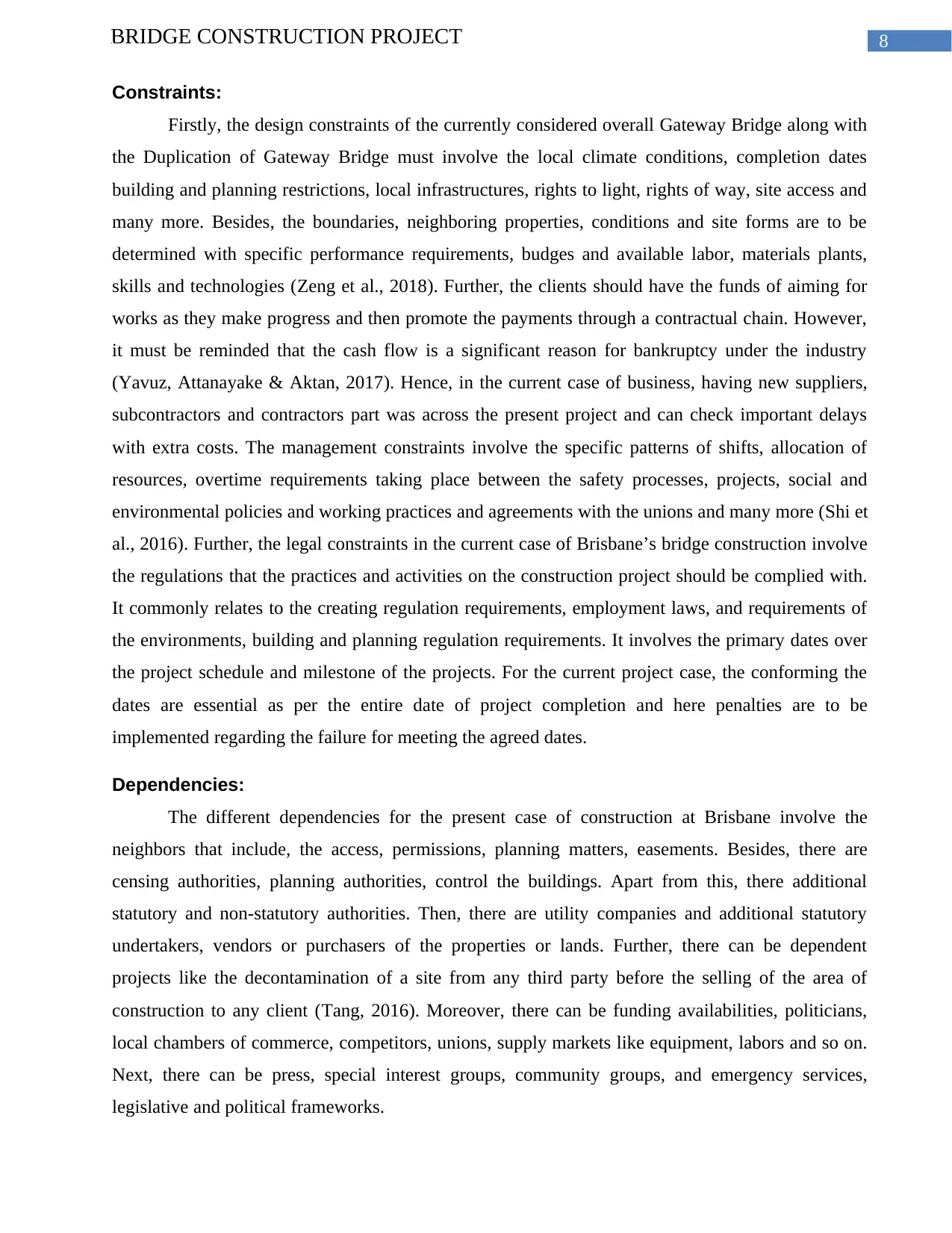
8BRIDGE CONSTRUCTION PROJECT
Constraints:
Firstly, the design constraints of the currently considered overall Gateway Bridge along with
the Duplication of Gateway Bridge must involve the local climate conditions, completion dates
building and planning restrictions, local infrastructures, rights to light, rights of way, site access and
many more. Besides, the boundaries, neighboring properties, conditions and site forms are to be
determined with specific performance requirements, budges and available labor, materials plants,
skills and technologies (Zeng et al., 2018). Further, the clients should have the funds of aiming for
works as they make progress and then promote the payments through a contractual chain. However,
it must be reminded that the cash flow is a significant reason for bankruptcy under the industry
(Yavuz, Attanayake & Aktan, 2017). Hence, in the current case of business, having new suppliers,
subcontractors and contractors part was across the present project and can check important delays
with extra costs. The management constraints involve the specific patterns of shifts, allocation of
resources, overtime requirements taking place between the safety processes, projects, social and
environmental policies and working practices and agreements with the unions and many more (Shi et
al., 2016). Further, the legal constraints in the current case of Brisbane’s bridge construction involve
the regulations that the practices and activities on the construction project should be complied with.
It commonly relates to the creating regulation requirements, employment laws, and requirements of
the environments, building and planning regulation requirements. It involves the primary dates over
the project schedule and milestone of the projects. For the current project case, the conforming the
dates are essential as per the entire date of project completion and here penalties are to be
implemented regarding the failure for meeting the agreed dates.
Dependencies:
The different dependencies for the present case of construction at Brisbane involve the
neighbors that include, the access, permissions, planning matters, easements. Besides, there are
censing authorities, planning authorities, control the buildings. Apart from this, there additional
statutory and non-statutory authorities. Then, there are utility companies and additional statutory
undertakers, vendors or purchasers of the properties or lands. Further, there can be dependent
projects like the decontamination of a site from any third party before the selling of the area of
construction to any client (Tang, 2016). Moreover, there can be funding availabilities, politicians,
local chambers of commerce, competitors, unions, supply markets like equipment, labors and so on.
Next, there can be press, special interest groups, community groups, and emergency services,
legislative and political frameworks.
Constraints:
Firstly, the design constraints of the currently considered overall Gateway Bridge along with
the Duplication of Gateway Bridge must involve the local climate conditions, completion dates
building and planning restrictions, local infrastructures, rights to light, rights of way, site access and
many more. Besides, the boundaries, neighboring properties, conditions and site forms are to be
determined with specific performance requirements, budges and available labor, materials plants,
skills and technologies (Zeng et al., 2018). Further, the clients should have the funds of aiming for
works as they make progress and then promote the payments through a contractual chain. However,
it must be reminded that the cash flow is a significant reason for bankruptcy under the industry
(Yavuz, Attanayake & Aktan, 2017). Hence, in the current case of business, having new suppliers,
subcontractors and contractors part was across the present project and can check important delays
with extra costs. The management constraints involve the specific patterns of shifts, allocation of
resources, overtime requirements taking place between the safety processes, projects, social and
environmental policies and working practices and agreements with the unions and many more (Shi et
al., 2016). Further, the legal constraints in the current case of Brisbane’s bridge construction involve
the regulations that the practices and activities on the construction project should be complied with.
It commonly relates to the creating regulation requirements, employment laws, and requirements of
the environments, building and planning regulation requirements. It involves the primary dates over
the project schedule and milestone of the projects. For the current project case, the conforming the
dates are essential as per the entire date of project completion and here penalties are to be
implemented regarding the failure for meeting the agreed dates.
Dependencies:
The different dependencies for the present case of construction at Brisbane involve the
neighbors that include, the access, permissions, planning matters, easements. Besides, there are
censing authorities, planning authorities, control the buildings. Apart from this, there additional
statutory and non-statutory authorities. Then, there are utility companies and additional statutory
undertakers, vendors or purchasers of the properties or lands. Further, there can be dependent
projects like the decontamination of a site from any third party before the selling of the area of
construction to any client (Tang, 2016). Moreover, there can be funding availabilities, politicians,
local chambers of commerce, competitors, unions, supply markets like equipment, labors and so on.
Next, there can be press, special interest groups, community groups, and emergency services,
legislative and political frameworks.
⊘ This is a preview!⊘
Do you want full access?
Subscribe today to unlock all pages.

Trusted by 1+ million students worldwide
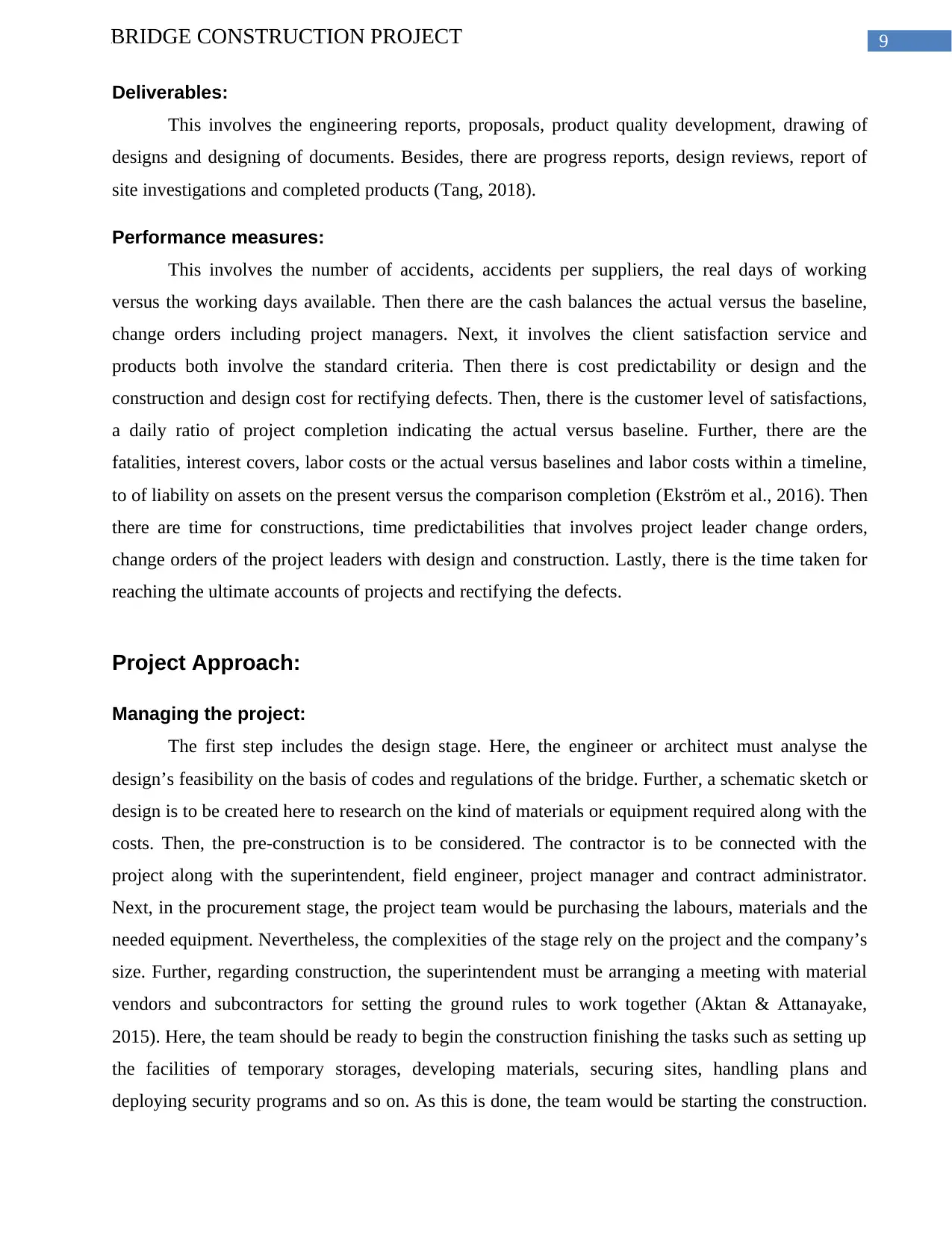
9BRIDGE CONSTRUCTION PROJECT
Deliverables:
This involves the engineering reports, proposals, product quality development, drawing of
designs and designing of documents. Besides, there are progress reports, design reviews, report of
site investigations and completed products (Tang, 2018).
Performance measures:
This involves the number of accidents, accidents per suppliers, the real days of working
versus the working days available. Then there are the cash balances the actual versus the baseline,
change orders including project managers. Next, it involves the client satisfaction service and
products both involve the standard criteria. Then there is cost predictability or design and the
construction and design cost for rectifying defects. Then, there is the customer level of satisfactions,
a daily ratio of project completion indicating the actual versus baseline. Further, there are the
fatalities, interest covers, labor costs or the actual versus baselines and labor costs within a timeline,
to of liability on assets on the present versus the comparison completion (Ekström et al., 2016). Then
there are time for constructions, time predictabilities that involves project leader change orders,
change orders of the project leaders with design and construction. Lastly, there is the time taken for
reaching the ultimate accounts of projects and rectifying the defects.
Project Approach:
Managing the project:
The first step includes the design stage. Here, the engineer or architect must analyse the
design’s feasibility on the basis of codes and regulations of the bridge. Further, a schematic sketch or
design is to be created here to research on the kind of materials or equipment required along with the
costs. Then, the pre-construction is to be considered. The contractor is to be connected with the
project along with the superintendent, field engineer, project manager and contract administrator.
Next, in the procurement stage, the project team would be purchasing the labours, materials and the
needed equipment. Nevertheless, the complexities of the stage rely on the project and the company’s
size. Further, regarding construction, the superintendent must be arranging a meeting with material
vendors and subcontractors for setting the ground rules to work together (Aktan & Attanayake,
2015). Here, the team should be ready to begin the construction finishing the tasks such as setting up
the facilities of temporary storages, developing materials, securing sites, handling plans and
deploying security programs and so on. As this is done, the team would be starting the construction.
Deliverables:
This involves the engineering reports, proposals, product quality development, drawing of
designs and designing of documents. Besides, there are progress reports, design reviews, report of
site investigations and completed products (Tang, 2018).
Performance measures:
This involves the number of accidents, accidents per suppliers, the real days of working
versus the working days available. Then there are the cash balances the actual versus the baseline,
change orders including project managers. Next, it involves the client satisfaction service and
products both involve the standard criteria. Then there is cost predictability or design and the
construction and design cost for rectifying defects. Then, there is the customer level of satisfactions,
a daily ratio of project completion indicating the actual versus baseline. Further, there are the
fatalities, interest covers, labor costs or the actual versus baselines and labor costs within a timeline,
to of liability on assets on the present versus the comparison completion (Ekström et al., 2016). Then
there are time for constructions, time predictabilities that involves project leader change orders,
change orders of the project leaders with design and construction. Lastly, there is the time taken for
reaching the ultimate accounts of projects and rectifying the defects.
Project Approach:
Managing the project:
The first step includes the design stage. Here, the engineer or architect must analyse the
design’s feasibility on the basis of codes and regulations of the bridge. Further, a schematic sketch or
design is to be created here to research on the kind of materials or equipment required along with the
costs. Then, the pre-construction is to be considered. The contractor is to be connected with the
project along with the superintendent, field engineer, project manager and contract administrator.
Next, in the procurement stage, the project team would be purchasing the labours, materials and the
needed equipment. Nevertheless, the complexities of the stage rely on the project and the company’s
size. Further, regarding construction, the superintendent must be arranging a meeting with material
vendors and subcontractors for setting the ground rules to work together (Aktan & Attanayake,
2015). Here, the team should be ready to begin the construction finishing the tasks such as setting up
the facilities of temporary storages, developing materials, securing sites, handling plans and
deploying security programs and so on. As this is done, the team would be starting the construction.
Paraphrase This Document
Need a fresh take? Get an instant paraphrase of this document with our AI Paraphraser
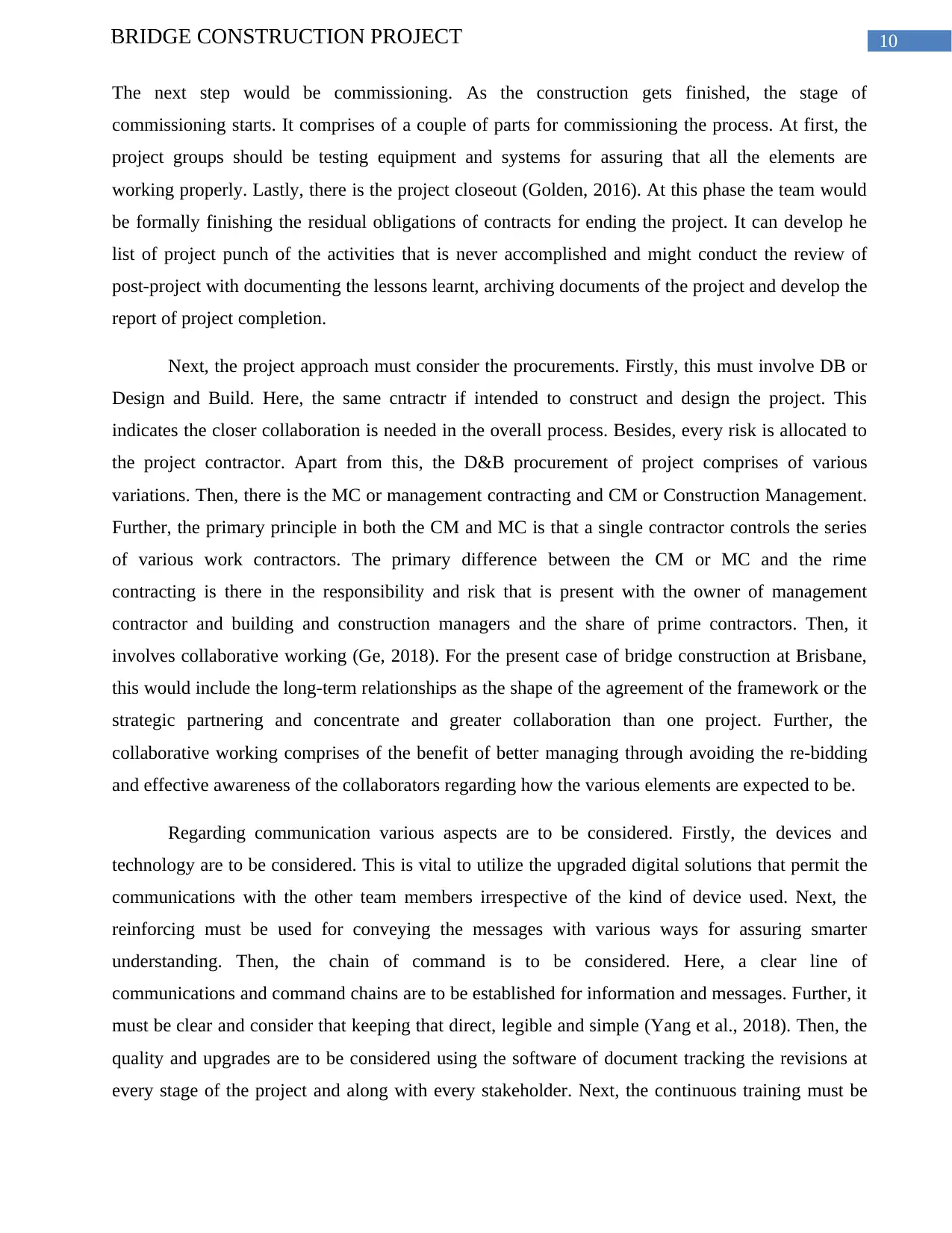
10BRIDGE CONSTRUCTION PROJECT
The next step would be commissioning. As the construction gets finished, the stage of
commissioning starts. It comprises of a couple of parts for commissioning the process. At first, the
project groups should be testing equipment and systems for assuring that all the elements are
working properly. Lastly, there is the project closeout (Golden, 2016). At this phase the team would
be formally finishing the residual obligations of contracts for ending the project. It can develop he
list of project punch of the activities that is never accomplished and might conduct the review of
post-project with documenting the lessons learnt, archiving documents of the project and develop the
report of project completion.
Next, the project approach must consider the procurements. Firstly, this must involve DB or
Design and Build. Here, the same cntractr if intended to construct and design the project. This
indicates the closer collaboration is needed in the overall process. Besides, every risk is allocated to
the project contractor. Apart from this, the D&B procurement of project comprises of various
variations. Then, there is the MC or management contracting and CM or Construction Management.
Further, the primary principle in both the CM and MC is that a single contractor controls the series
of various work contractors. The primary difference between the CM or MC and the rime
contracting is there in the responsibility and risk that is present with the owner of management
contractor and building and construction managers and the share of prime contractors. Then, it
involves collaborative working (Ge, 2018). For the present case of bridge construction at Brisbane,
this would include the long-term relationships as the shape of the agreement of the framework or the
strategic partnering and concentrate and greater collaboration than one project. Further, the
collaborative working comprises of the benefit of better managing through avoiding the re-bidding
and effective awareness of the collaborators regarding how the various elements are expected to be.
Regarding communication various aspects are to be considered. Firstly, the devices and
technology are to be considered. This is vital to utilize the upgraded digital solutions that permit the
communications with the other team members irrespective of the kind of device used. Next, the
reinforcing must be used for conveying the messages with various ways for assuring smarter
understanding. Then, the chain of command is to be considered. Here, a clear line of
communications and command chains are to be established for information and messages. Further, it
must be clear and consider that keeping that direct, legible and simple (Yang et al., 2018). Then, the
quality and upgrades are to be considered using the software of document tracking the revisions at
every stage of the project and along with every stakeholder. Next, the continuous training must be
The next step would be commissioning. As the construction gets finished, the stage of
commissioning starts. It comprises of a couple of parts for commissioning the process. At first, the
project groups should be testing equipment and systems for assuring that all the elements are
working properly. Lastly, there is the project closeout (Golden, 2016). At this phase the team would
be formally finishing the residual obligations of contracts for ending the project. It can develop he
list of project punch of the activities that is never accomplished and might conduct the review of
post-project with documenting the lessons learnt, archiving documents of the project and develop the
report of project completion.
Next, the project approach must consider the procurements. Firstly, this must involve DB or
Design and Build. Here, the same cntractr if intended to construct and design the project. This
indicates the closer collaboration is needed in the overall process. Besides, every risk is allocated to
the project contractor. Apart from this, the D&B procurement of project comprises of various
variations. Then, there is the MC or management contracting and CM or Construction Management.
Further, the primary principle in both the CM and MC is that a single contractor controls the series
of various work contractors. The primary difference between the CM or MC and the rime
contracting is there in the responsibility and risk that is present with the owner of management
contractor and building and construction managers and the share of prime contractors. Then, it
involves collaborative working (Ge, 2018). For the present case of bridge construction at Brisbane,
this would include the long-term relationships as the shape of the agreement of the framework or the
strategic partnering and concentrate and greater collaboration than one project. Further, the
collaborative working comprises of the benefit of better managing through avoiding the re-bidding
and effective awareness of the collaborators regarding how the various elements are expected to be.
Regarding communication various aspects are to be considered. Firstly, the devices and
technology are to be considered. This is vital to utilize the upgraded digital solutions that permit the
communications with the other team members irrespective of the kind of device used. Next, the
reinforcing must be used for conveying the messages with various ways for assuring smarter
understanding. Then, the chain of command is to be considered. Here, a clear line of
communications and command chains are to be established for information and messages. Further, it
must be clear and consider that keeping that direct, legible and simple (Yang et al., 2018). Then, the
quality and upgrades are to be considered using the software of document tracking the revisions at
every stage of the project and along with every stakeholder. Next, the continuous training must be
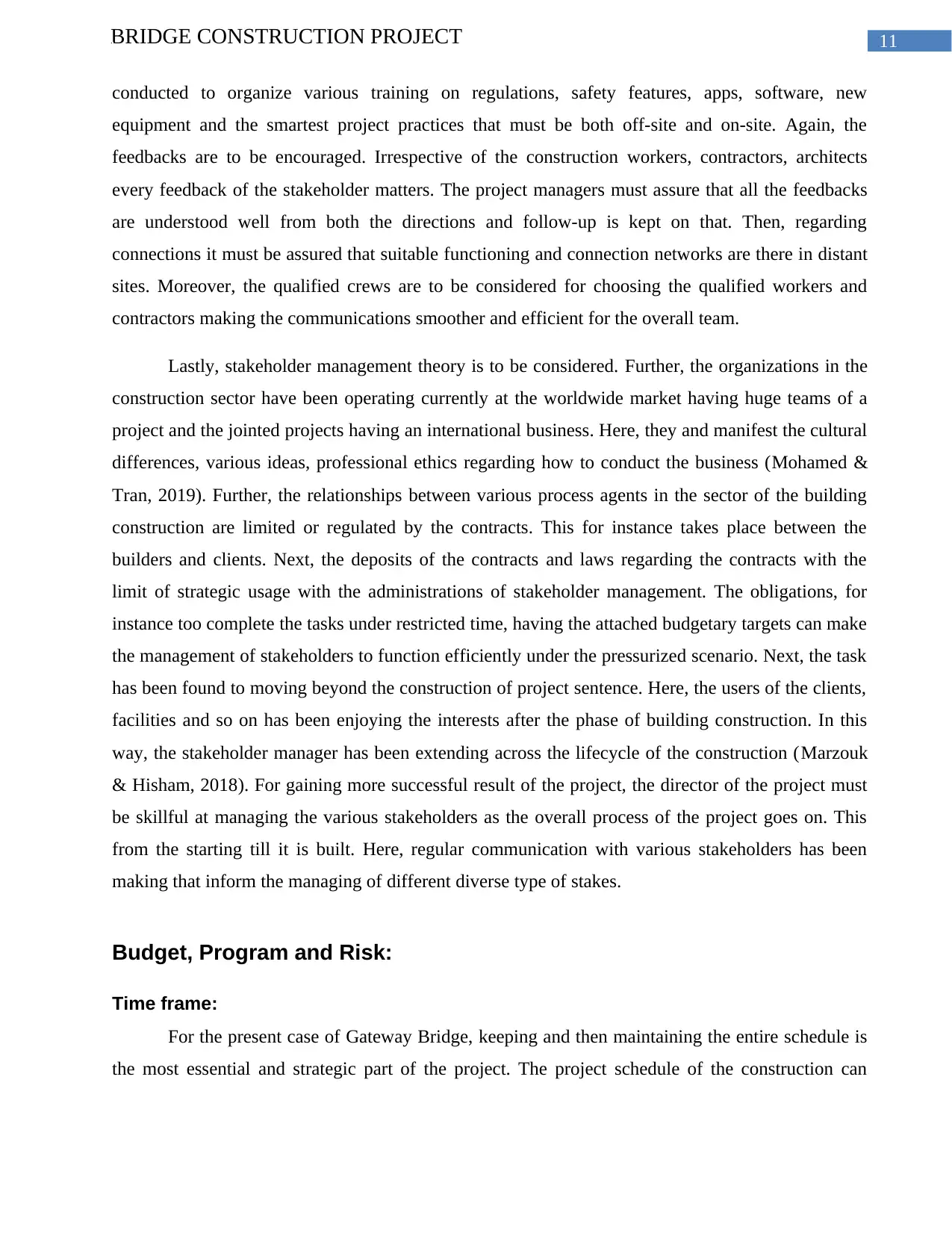
11BRIDGE CONSTRUCTION PROJECT
conducted to organize various training on regulations, safety features, apps, software, new
equipment and the smartest project practices that must be both off-site and on-site. Again, the
feedbacks are to be encouraged. Irrespective of the construction workers, contractors, architects
every feedback of the stakeholder matters. The project managers must assure that all the feedbacks
are understood well from both the directions and follow-up is kept on that. Then, regarding
connections it must be assured that suitable functioning and connection networks are there in distant
sites. Moreover, the qualified crews are to be considered for choosing the qualified workers and
contractors making the communications smoother and efficient for the overall team.
Lastly, stakeholder management theory is to be considered. Further, the organizations in the
construction sector have been operating currently at the worldwide market having huge teams of a
project and the jointed projects having an international business. Here, they and manifest the cultural
differences, various ideas, professional ethics regarding how to conduct the business (Mohamed &
Tran, 2019). Further, the relationships between various process agents in the sector of the building
construction are limited or regulated by the contracts. This for instance takes place between the
builders and clients. Next, the deposits of the contracts and laws regarding the contracts with the
limit of strategic usage with the administrations of stakeholder management. The obligations, for
instance too complete the tasks under restricted time, having the attached budgetary targets can make
the management of stakeholders to function efficiently under the pressurized scenario. Next, the task
has been found to moving beyond the construction of project sentence. Here, the users of the clients,
facilities and so on has been enjoying the interests after the phase of building construction. In this
way, the stakeholder manager has been extending across the lifecycle of the construction (Marzouk
& Hisham, 2018). For gaining more successful result of the project, the director of the project must
be skillful at managing the various stakeholders as the overall process of the project goes on. This
from the starting till it is built. Here, regular communication with various stakeholders has been
making that inform the managing of different diverse type of stakes.
Budget, Program and Risk:
Time frame:
For the present case of Gateway Bridge, keeping and then maintaining the entire schedule is
the most essential and strategic part of the project. The project schedule of the construction can
conducted to organize various training on regulations, safety features, apps, software, new
equipment and the smartest project practices that must be both off-site and on-site. Again, the
feedbacks are to be encouraged. Irrespective of the construction workers, contractors, architects
every feedback of the stakeholder matters. The project managers must assure that all the feedbacks
are understood well from both the directions and follow-up is kept on that. Then, regarding
connections it must be assured that suitable functioning and connection networks are there in distant
sites. Moreover, the qualified crews are to be considered for choosing the qualified workers and
contractors making the communications smoother and efficient for the overall team.
Lastly, stakeholder management theory is to be considered. Further, the organizations in the
construction sector have been operating currently at the worldwide market having huge teams of a
project and the jointed projects having an international business. Here, they and manifest the cultural
differences, various ideas, professional ethics regarding how to conduct the business (Mohamed &
Tran, 2019). Further, the relationships between various process agents in the sector of the building
construction are limited or regulated by the contracts. This for instance takes place between the
builders and clients. Next, the deposits of the contracts and laws regarding the contracts with the
limit of strategic usage with the administrations of stakeholder management. The obligations, for
instance too complete the tasks under restricted time, having the attached budgetary targets can make
the management of stakeholders to function efficiently under the pressurized scenario. Next, the task
has been found to moving beyond the construction of project sentence. Here, the users of the clients,
facilities and so on has been enjoying the interests after the phase of building construction. In this
way, the stakeholder manager has been extending across the lifecycle of the construction (Marzouk
& Hisham, 2018). For gaining more successful result of the project, the director of the project must
be skillful at managing the various stakeholders as the overall process of the project goes on. This
from the starting till it is built. Here, regular communication with various stakeholders has been
making that inform the managing of different diverse type of stakes.
Budget, Program and Risk:
Time frame:
For the present case of Gateway Bridge, keeping and then maintaining the entire schedule is
the most essential and strategic part of the project. The project schedule of the construction can
⊘ This is a preview!⊘
Do you want full access?
Subscribe today to unlock all pages.

Trusted by 1+ million students worldwide
1 out of 24
Related Documents
Your All-in-One AI-Powered Toolkit for Academic Success.
+13062052269
info@desklib.com
Available 24*7 on WhatsApp / Email
![[object Object]](/_next/static/media/star-bottom.7253800d.svg)
Unlock your academic potential
Copyright © 2020–2025 A2Z Services. All Rights Reserved. Developed and managed by ZUCOL.





